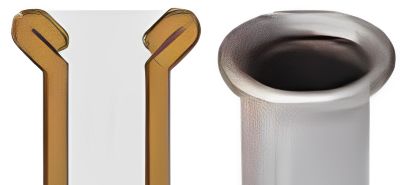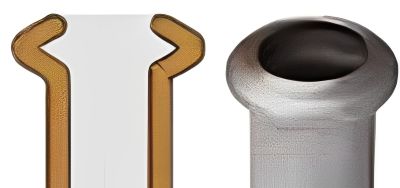Brake line flares play a crucial role in automotive braking systems, ensuring a secure and leak-proof connection between brake lines and fittings. Choosing the right type of flare is essential for safety, performance, and compatibility with your vehicle’s braking system.
The two most common types of brake line flares are double flare and bubble flare. Understanding their differences will help you determine which one is best suited for your vehicle.
What is a Double Flare?
A double flare, also known as an inverted flare, is a widely used type of brake line flare in automotive applications, particularly in the United States. It involves folding the metal tubing onto itself before creating a flare, resulting in a stronger and more durable connection.
How It Is Created
The process of making a double flare involves several steps:
1. Cutting – The brake line is cut to the desired length.
2. Deburring – The inner and outer edges of the tube are smoothed to prevent irregularities.
3. Flaring – A specialized flaring tool is used to create a 45-degree flare, which is then folded back on itself and re-flared to form a double layer.
Common Applications
➡️ Primarily used in U.S. vehicles.
➡️ Compliant with SAE (Society of Automotive Engineers) standards.
➡️ Found in high-pressure braking systems.
Advantages of Using a Double Flare
➡️ Stronger and more durable due to the double-layered structure.
➡️ Better sealing against leaks.
➡️ More resistant to cracking under pressure.
What is a Bubble Flare?
A bubble flare, also known as an ISO flare, is commonly found in European vehicles and certain modern braking systems. It features a single flared end with a rounded or “bubble” shape that provides a secure connection when compressed against a fitting.
How It Is Created
The process of making a bubble flare includes:
1. Cutting – The brake line is cut to size.
2. Deburring – The edges are smoothed to eliminate sharp edges.
3. Flaring – A flaring tool shapes the tubing end into a rounded bubble, which then fits securely into a corresponding fitting.
Common Applications
➡️ Used primarily in European and some Asian vehicles.
➡️ Compliant with ISO (International Organization for Standardization) standards.
➡️ Found in modern hydraulic brake systems.
Advantages of Using a Bubble Flare
➡️ Simple and quick to create compared to double flares.
➡️ Good sealing capability when used with compatible fittings.
➡️ Less material stress due to the single flare design.
Key Differences Between Double Flare and Bubble Flare
Shape & Structure
➡️ Double Flare: Inverted, double-layered flare with a 45-degree angle.
➡️ Bubble Flare: Single-layered flare with a rounded “bubble” shape.
Strength & Durability
➡️ Double Flare: More durable due to the double layer, making it stronger under high pressure.
➡️ Bubble Flare: Slightly less durable but still effective in hydraulic systems.
Application & Compatibility
➡️ Double Flare: Found in U.S. vehicles and SAE standard brake lines.
➡️ Bubble Flare: Common in European vehicles and ISO standard brake lines.
Installation Process
➡️ Double Flare: Requires a two-step flaring process, making it slightly more complex.
➡️ Bubble Flare: Created in a single flaring step, making it quicker to install.
Safety & Performance
➡️ Double Flare: Offers a superior seal and better resistance to high pressure.
➡️ Bubble Flare: Works well but requires precise installation to prevent leaks.
How to Choose the Right Flare for Your Brake Line
Identifying Your Vehicle’s Brake System Requirements
➡️ Check your vehicle’s manual or manufacturer specifications to determine the required flare type.
Checking Manufacturer Specifications
➡️ U.S. vehicles typically use double flares, while European models often require bubble flares.
Understanding Local and International Standards
➡️ SAE standards govern double flares in the U.S.
➡️ ISO standards define bubble flares in Europe and other regions.
Tools Required for Flaring Brake Lines
Flaring Tool Kit Overview
To create a proper flare, you’ll need:
➡️ Flaring tool (with adapters for double or bubble flares)
➡️ Tube cutter
➡️ Deburring tool
➡️ Brake line clamps
➡️ Brake fluid-resistant gloves (for safety)
Key Tools for Creating Double and Bubble Flares
➡️ Double flare tools require a two-step die set.
➡️ Bubble flare tools use a single-step die.
Safety Tips When Flaring Brake Lines
➡️ Ensure a clean cut to prevent uneven flares.
➡️ Properly deburr the edges to avoid cracks or weak spots.
➡️ Use high-quality tools to create precise and secure flares.
Common Mistakes to Avoid
Incorrect Flare Type for the Application
➡️ Using a double flare in a system requiring a bubble flare (or vice versa) can lead to leakage and brake failure.
Poorly Made Flares Leading to Leaks
➡️ Incomplete or uneven flares can cause fluid leaks, reducing braking efficiency.
Using Low-Quality Tools
➡️ Cheap tools can create weak, misshaped flares that compromise safety.
Not Properly Deburring or Prepping the Brake Line
➡️ Rough edges weaken the flare and reduce its sealing capability.
Conclusion
Understanding the key differences between double flare and bubble flare is essential for maintaining a safe and efficient brake system.
➡️ Double flares offer greater strength and durability, making them ideal for high-pressure braking systems, particularly in U.S. vehicles.
➡️ Bubble flares provide good sealing and ease of installation, commonly found in European and ISO-standard brake lines.
Choosing the right flare ensures better performance, safety, and compliance with vehicle standards. Whether you are a professional mechanic or a DIY enthusiast, using the correct tools and following proper procedures will help you achieve reliable brake line connections.
Post time: Mar-25-2025



